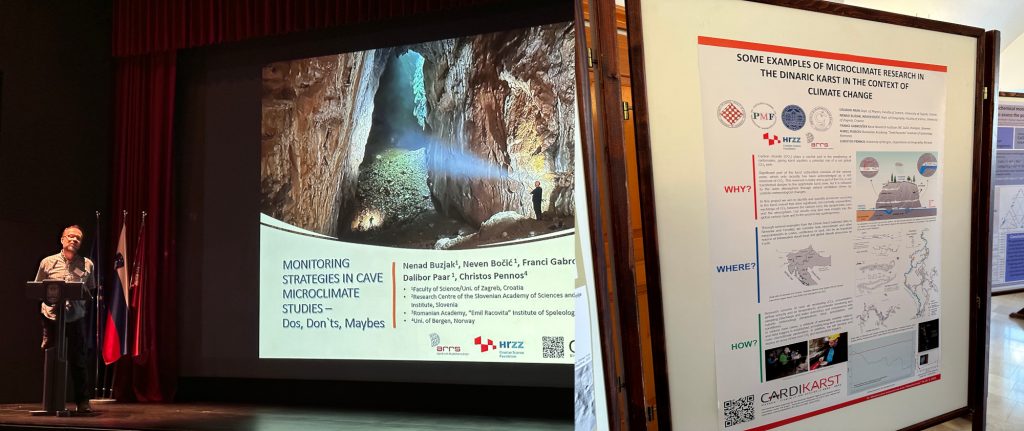At the jubilee 30th International Karstological School organized by the Karst Research Institute ZRC SAZU (19.-23. June 2023.), the CARDIKARST project presented was presented with two presentations.
Abstracts:
Monitoring strategies in cave microclimate monitoring studies – Dos, Don’ts, Maybes
Nenad Buzjak1, Neven Bočić1, Franci Gabrovšek2, Aurel Persoiu3, Dalibor Paar4, Christos Pennos5
1 Department of Geography, Faculty of Science, University of Zagreb, 10000 Zagreb, Croatia, nbuzjak@geog.pmf.hr
2 Karst Research Institute ZRC SAZU, Postojna, Slovenia
3 Romanian Academy, “Emil Racovita” Institute of Speleology, Str. Clinicilor 5, Cluj-Napoca 400535, Romania
4 Department of Physics, Faculty of Science, University of Zagreb, Bijenička cesta 32, 10000 Zagreb, Croatia
5 Department of Geography, University of Bergen, NO-5020 Bergen, Norway
The planning of microclimatic measurements in caves depends on numerous factors. These include
the known ones, such as adequate funding and available measurement equipment, their capabilities
and limitations, and the creativity and improvisational skills of the researcher. In order to develop a
strategy for continuous monitoring of microclimate and to study the fluctuations of CO2 concentration
under the conditions of limited financial resources and measuring devices, different measurement
methods were applied in Samograd Cave and Barać Caves in Croatia: continuous measurements with
loggers and spot measurements with hand-held measuring devices. We pursued the following
objectives: representativeness (spatially and temporally, e.g., coverage of the entire year/seasons),
comparability, and long-term measurements to collect data series over the years in an attempt to
discover regularities. Each of the measurement methods used has its advantages and disadvantages,
which we would like to present. With the previous financial support of the Public Institution Cave Park
Grabovača and the Public Institution Barać Caves, a series of data on air temperature, relative humidity
and CO2 concentration on different time scales have been collected in this way in recent years. These
data are useful for microclimate research, sustainable management of tourist caves and planning of
further research. With the start of the CARDIKARST project, there are new opportunities for research
work based on the above experience. This work is supported by the Slovenian Research Agency and
the Croatian Science Foundation within the project Dynamics and distribution of CO2 in karst vadose
and epiphreatic zone (CARDIKARST) IPS -2022-02-2260.
Some examples of microclimate research in the Dinaric Karst in the context of climate change
Dalibor Paar1, Nenad Buzjak2, Neven Bočić2, Franci Gabrovšek3, Aurel Persoiu4, Christos Pennos5
1 Department of Physics, Faculty of Science, University of Zagreb, 10000 Zagreb, Croatia, dpaar.phy@pmf.hr
2 Department of Geography, Faculty of Science, University of Zagreb, Ilica 242, 10000 Zagreb, Croatia
3 Karst Research Institute ZRC SAZU, Postojna, Slovenia
4 Romanian Academy, “Emil Racovita” Institute of Speleology, Str. Clinicilor 5, Cluj-Napoca 400535, Romania
5 University of Bergen, Department of Geography, Fosswinckelsgt. 6, NO-5020 Bergen, Norway
Caves are a relevant source of information about events on the Earth’s surface. Caves are more stable
and clearly defined systems compared to surface ones. Through several examples from the Dinaric
karst, we will consider how microclimate and other measurements in caves, continuous or spot, can
be an important source of information about local and global climate processes on Earth. The focus of
our research is carbon dioxide that plays a central part in the weathering of carbonates, giving karst
aquifers a potential role of a net global CO2 sink. This work has been supported by the Slovenian
Research Agency and Croatian Science Foundation under the project Dynamics and distribution of CO2
in karst vadose and epiphreatic zone (CARDIKARST) IPS-2022-02-2260.
Photo: Dalibor Paar

